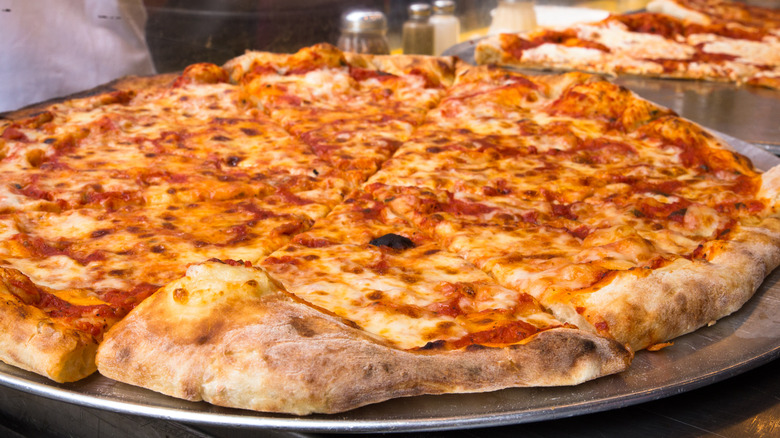The 2 Ingredients That Set New York Pizza Dough Apart
When you think of pizza, you think of three main ingredients: dough, sauce, and cheese. These three simple ingredients are the backbone of every good pizza and, like any dish, have their own unique variations from region to region and recipe to recipe. Many different chefs, restaurants, and recipes call for different methods of preparing the dough or the taste of the tomato sauce.
Take, for example, New York-style pizza. New York Eater best describes this style of pizza as being round, usually covered with cheese that covers the entirety of the pizza, and having a crispy, yet chewy thin crust– in short, what you usually think of when you think of a classic "pizzeria pizza." Compare New York-style pizza's flat form to that of Chicago-style, where the crust of the pizza is deeper and denser and is layered with hefty amounts of sauce, cheeses, and toppings that make it more of a "casserole" (via Aversano's).
Differences in shape and size aside, it still seems that New York, Chicago, and all other styles of pizza share the same common ingredients of dough, sauce, and cheese, meaning that the only differences lie in how these pizzas are cooked. But does New York-style, the quintessential thin and tender pizza popular in pizzerias across the nation, have any "secret ingredients" in its dough that set it apart from its rivals?
Oil and sugar are two key components in New York pizza
The most basic ingredients of pizza dough include yeast, flour, water, and salt. While these are important ingredients in any good pizza dough recipe to be sure, New York-style pizza has two extra ingredients that help give its classic texture, taste, and "foldability."
According to J. Kenji Lopez-Alt of Serious Eats, oil, when added to the dough, covers the granules of flour the dough is rolled in. This lowers the amount of gluten formed because, as King Arthur Baking explains, the resulting product would become tough and chewy. By keeping too much gluten from developing, the oil helps to keep the pizza light and tender, giving it that airy foldable crust rather than a dense bread-like consistency.
Sugar also plays a key role in the development of the pizza's trademark texture and taste. The caramelization of the sugar within the dough helps to give the crust its golden-brown color, albeit without giving it too much of a sweet, sugary taste. Without sugar, the crust would brown unevenly in some places, leading to a pale, seemingly undercooked crust.
Although sugar and oil give New York-style pizza its classic color and texture, there's one more ingredient that helps separate this particular style of pizza from its predecessors.
New York-style pizzas also use low-moisture mozzarella
It goes without saying that nothing makes a New York-style pizza like taking the first bite of a slice and pulling a long string of hot melted cheese right off it. It's this specific type of cheese that most New York-style pizzas use that make them so beloved: low-moisture mozzarella. But why use that one type of mozzarella rather than the fresh kind? Wouldn't that be an insult to New York's Italian roots?
According to Crust Kingdom, the reason most New York pizzerias use low-moisture mozzarella is not that there's some prejudice against fresh mozzarella, but because the fresh stuff simply wouldn't work on this type of pizza. New York-style pizza needs to spend a long time baking in the oven, something that fresh mozzarella wouldn't be able to handle without melting and becoming watery.
Low-moisture mozzarella is also good for shredding, which is important if you want to cover the whole pizza in cheese rather than select spots. Low-moisture mozzarella, explains Pizzeria Locale, is just easier to use than fresh mozzarella and makes good-quality pizza without sacrificing too much.
Of course, this doesn't mean that fresh mozzarella isn't a good choice for making a pizza at home. Although it can be tricky, we'll fill you in on the secret to using fresh mozzarella when making pizza.


